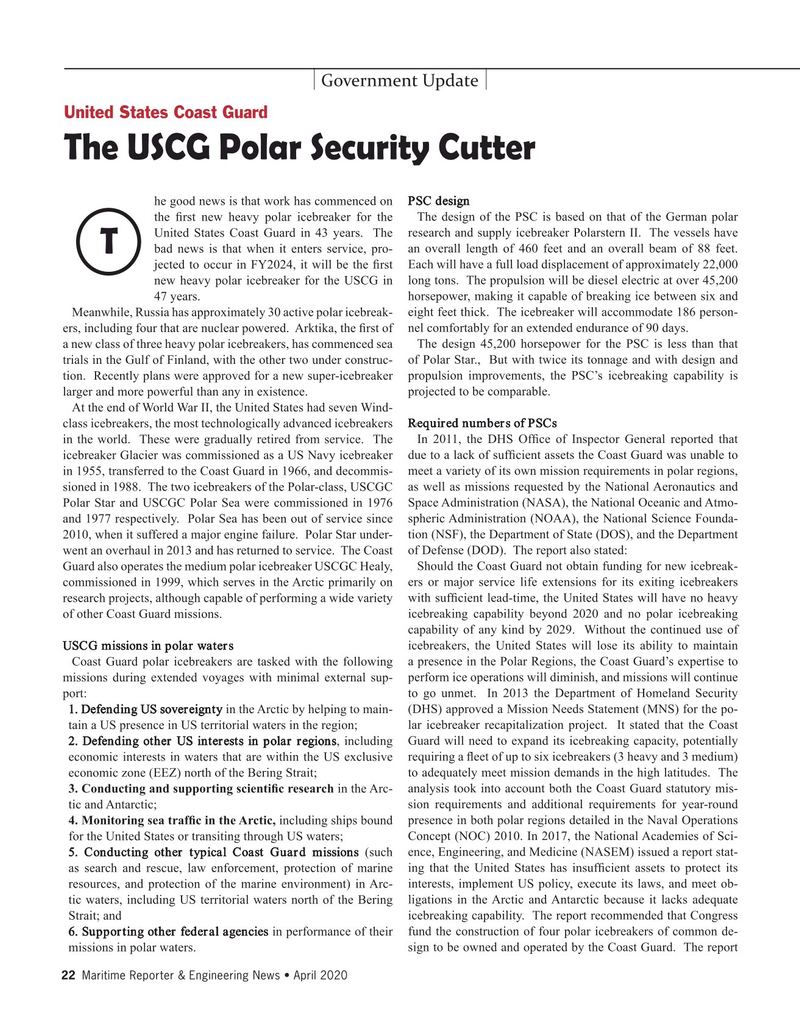
Page 22: of Maritime Reporter Magazine (April 2020)
Offshore Energy Edition
Read this page in Pdf, Flash or Html5 edition of April 2020 Maritime Reporter Magazine
Government Update
United States Coast Guard
The USCG Polar Security Cutter he good news is that work has commenced on PSC design the frst new heavy polar icebreaker for the The design of the PSC is based on that of the German polar
United States Coast Guard in 43 years. The research and supply icebreaker Polarstern II. The vessels have bad news is that when it enters service, pro- an overall length of 460 feet and an overall beam of 88 feet.
T jected to occur in FY2024, it will be the frst Each will have a full load displacement of approximately 22,000 new heavy polar icebreaker for the USCG in long tons. The propulsion will be diesel electric at over 45,200 47 years. horsepower, making it capable of breaking ice between six and
Meanwhile, Russia has approximately 30 active polar icebreak- eight feet thick. The icebreaker will accommodate 186 person- ers, including four that are nuclear powered. Arktika, the frst of nel comfortably for an extended endurance of 90 days.
a new class of three heavy polar icebreakers, has commenced sea The design 45,200 horsepower for the PSC is less than that trials in the Gulf of Finland, with the other two under construc- of Polar Star., But with twice its tonnage and with design and tion. Recently plans were approved for a new super-icebreaker propulsion improvements, the PSC’s icebreaking capability is larger and more powerful than any in existence. projected to be comparable.
At the end of World War II, the United States had seven Wind- class icebreakers, the most technologically advanced icebreakers Required numbers of PSCs in the world. These were gradually retired from service. The In 2011, the DHS Offce of Inspector General reported that icebreaker Glacier was commissioned as a US Navy icebreaker due to a lack of suffcient assets the Coast Guard was unable to in 1955, transferred to the Coast Guard in 1966, and decommis- meet a variety of its own mission requirements in polar regions, sioned in 1988. The two icebreakers of the Polar-class, USCGC as well as missions requested by the National Aeronautics and
Polar Star and USCGC Polar Sea were commissioned in 1976 Space Administration (NASA), the National Oceanic and Atmo- and 1977 respectively. Polar Sea has been out of service since spheric Administration (NOAA), the National Science Founda- 2010, when it suffered a major engine failure. Polar Star under- tion (NSF), the Department of State (DOS), and the Department went an overhaul in 2013 and has returned to service. The Coast of Defense (DOD). The report also stated:
Guard also operates the medium polar icebreaker USCGC Healy, Should the Coast Guard not obtain funding for new icebreak- commissioned in 1999, which serves in the Arctic primarily on ers or major service life extensions for its exiting icebreakers research projects, although capable of performing a wide variety with suffcient lead-time, the United States will have no heavy of other Coast Guard missions. icebreaking capability beyond 2020 and no polar icebreaking capability of any kind by 2029. Without the continued use of
USCG missions in polar waters icebreakers, the United States will lose its ability to maintain
Coast Guard polar icebreakers are tasked with the following a presence in the Polar Regions, the Coast Guard’s expertise to missions during extended voyages with minimal external sup- perform ice operations will diminish, and missions will continue port: to go unmet. In 2013 the Department of Homeland Security 1. Defending US sovereignty in the Arctic by helping to main- (DHS) approved a Mission Needs Statement (MNS) for the po- tain a US presence in US territorial waters in the region; lar icebreaker recapitalization project. It stated that the Coast 2. Defending other US interests in polar regions, including Guard will need to expand its icebreaking capacity, potentially economic interests in waters that are within the US exclusive requiring a feet of up to six icebreakers (3 heavy and 3 medium) economic zone (EEZ) north of the Bering Strait; to adequately meet mission demands in the high latitudes. The 3. Conducting and supporting scientifc research in the Arc- analysis took into account both the Coast Guard statutory mis- tic and Antarctic; sion requirements and additional requirements for year-round 4. Monitoring sea traffc in the Arctic, including ships bound presence in both polar regions detailed in the Naval Operations for the United States or transiting through US waters; Concept (NOC) 2010. In 2017, the National Academies of Sci- 5. Conducting other typical Coast Guard missions (such ence, Engineering, and Medicine (NASEM) issued a report stat- as search and rescue, law enforcement, protection of marine ing that the United States has insuffcient assets to protect its resources, and protection of the marine environment) in Arc- interests, implement US policy, execute its laws, and meet ob- tic waters, including US territorial waters north of the Bering ligations in the Arctic and Antarctic because it lacks adequate
Strait; and icebreaking capability. The report recommended that Congress 6. Supporting other federal agencies in performance of their fund the construction of four polar icebreakers of common de- missions in polar waters. sign to be owned and operated by the Coast Guard. The report 22 Maritime Reporter & Engineering News • April 2020

 21
21

 23
23
